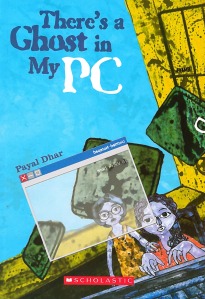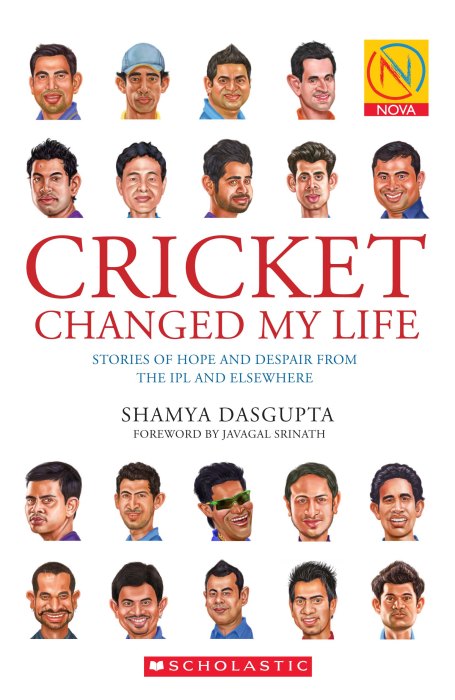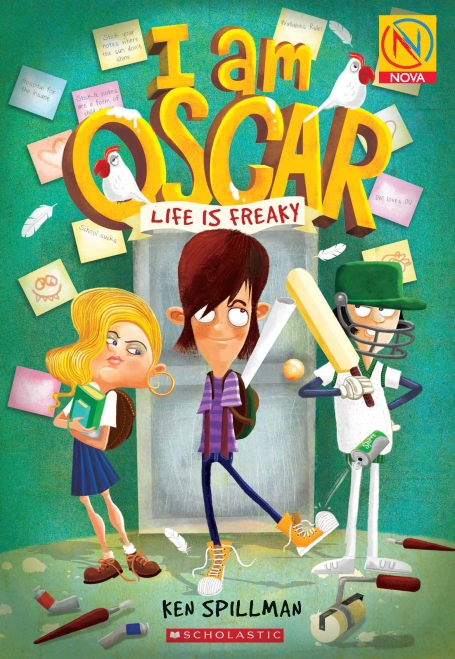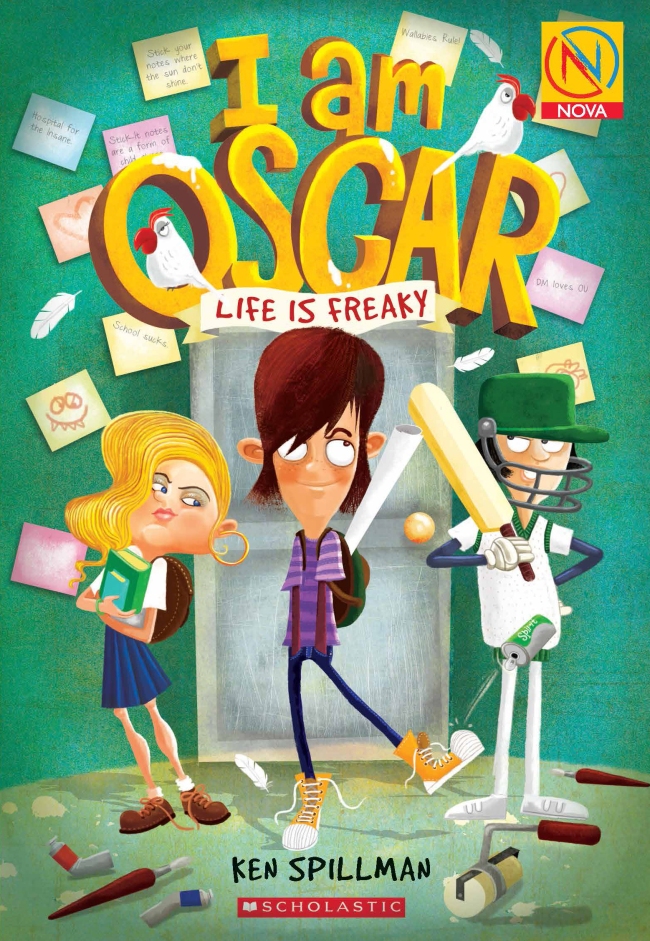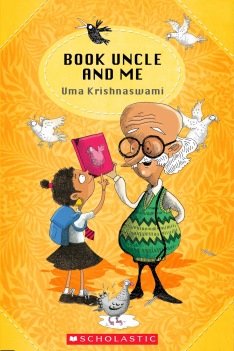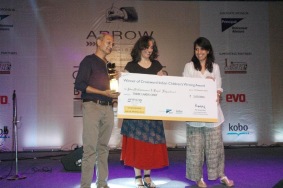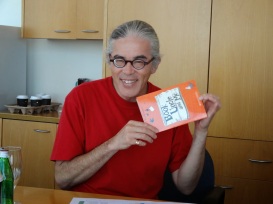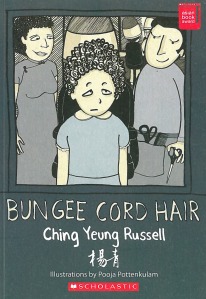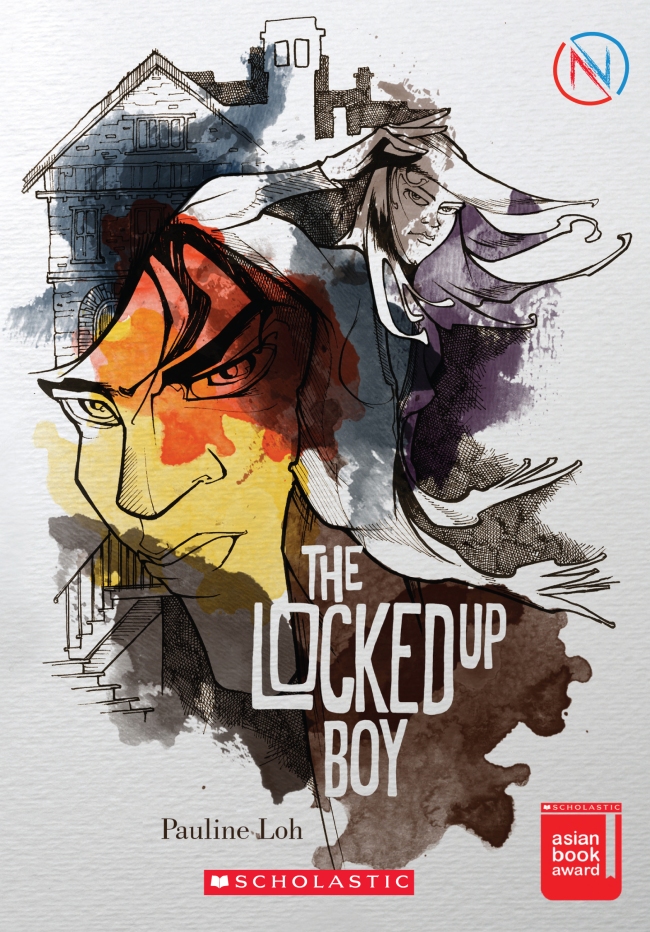It’s been a roller-coaster ride for Ela and me. (I know, I know, technically that should be Ela and I!)
Well then, in February this year, Ela and I took the Kala Ghoda chariot from school to school in South Mumbai, before she was ‘officially’ launched at Kitab Khana, my favourite book shop in Mumbai on the 8th, as part of KGAF (Kala Ghoda Arts Festival) 2014.
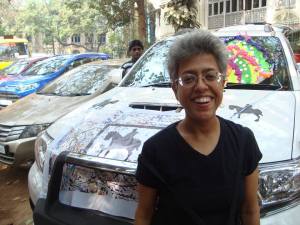
With the Kala Ghoda chariot
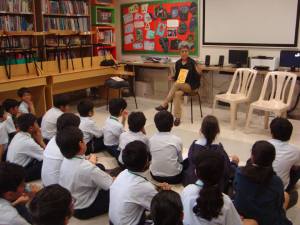
The Fried Frog goes to school
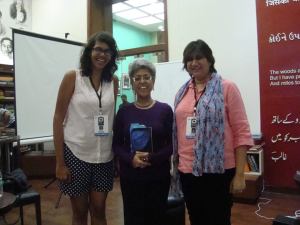
With Parinita Shetty and Lubaina Bandukwala, conspirators and organisers of the Children’s section of KGAF 2014
A close friend’s daughter, Aashya Abubaker (who is also a voracious reader), was good enough to indulge my desire of having a 13-year old launch my book about a 13-year old! The audience, comprising kids from various schools, barraged me with questions, and by the end of almost two hours of reading, interaction and book-signing, I was exhausted and utterly blissful.
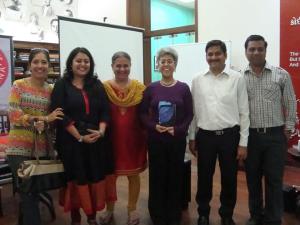
With the happy Scholastic team. Hooray!
In March, I was invited to the first Chandigarh Children’s Literature Festival. Apart from a poetry workshop (where I used examples from my very own Fried Frog) I had a session all to myself—the very last session of the festival, as it turned out!—to hold forth on Ela. A tricky proposition, given that the venue was a vast auditorium, and the kids would naturally have been flagging by the end of the day, and eager to go home. Luckily, I did manage to hold their interest and attention, and as always, my favourite part was the interaction with the kids. Since I had spoken about the trauma that Ela goes through, one little boy asked me in a woebegone voice, “I hope she doesn’t die?” I was glad to be able to reassure him that whatever horrors may be in store for Ela, however strong her death wish may have been (after all the novel does begin with the line: The day I turned thirteen was the day I wanted to die), by the time the novel ends, she realises that life may not be so awful after all; that in fact the book is proof that Ela survives to tell the tale, the story of her ordeal, and the way in which the writing of a fantasy helps her deal with a reality that had felt too grim to bear.
The month of May found me at the Abu Dhabi International Book Fair 2014, where, apart from events to do with my translation, poetry and fiction for adults, I had been scheduled for two separate stand-alone book-readings and signings on May 1st and May 3rd from The Fried Frog and Ela respectively. My friend, the talented and witty Palestinian-Icelandic poet Mazen Marouf, did me the honour of introducing me to the kids in Arabic, making them laugh out loud as he confided in them that he was actually the mysterious Fried Frog himself, who had popped out in human form only to introduce me before vanishing back into the book!
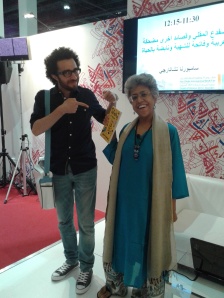
In which Palestinian-Icelandic poet Mazen Marouf introduces The Fried Frog and its author at the Abu Dhabi International Book Fair 2014
The session was fun, especially getting to read my poem ‘On blushes, jealousy and skirts’ to a trio of burqa-clad teenage friends who turned up right at the end!
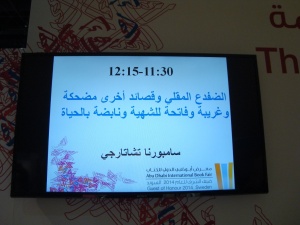
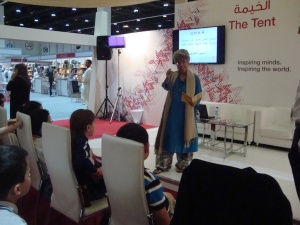
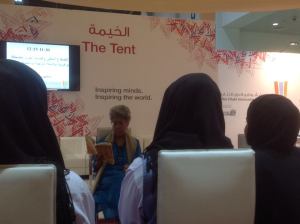
Reading my poem ‘On blushes, jealousy and skirts’ at ADIBF 2014
Come 9th May, which also happened to be Tagore’s birthday, Ela was launched in Kolkata to a packed house at Starmark. What made this very special for me was the fact that my dear friend, and fellow-author, Ken Spillman postponed his departure for Australia by a day in order to be there for my event. The conversation with Ken was extraordinarily rich, not only because Ken had already read Ela with his customary insight and perception, but also because he has read my other fiction as well. So he was able to draw out the links between my work, be it for old adults or young adults, for example the role of storytelling as a healing force; my concern with young people suffering physical or emotional trauma and so on. At key moments in our conversation we had 5 youngsters reading passages from the book. My dear friend Ruchira Das had ‘cast’ the children appropriately, based on my character briefs, and they read the extracts I had selected with verve, emotion and humour. For me it was extraordinary to hear my words take on a whole new dimension in the intonations and voices of the young people who until then had spoken only inside my head. And then of course we had questions from the audience, which included school kids, teachers, principals, and families, parents, kids and grandparents. Followed by book-signings, photo ops, and one in-depth interview by the editorial team of a school magazine. (They had promised me a copy of their magazine, but since that hasn’t happened yet, I append the interview at the end of this post.* And for those interested in photos and other coverage, all of that can be found here, on my website.)
And June, just gone, was my first experience at the AFCC (Asian Festival of Children’s Content), Singapore, a marvellous gathering of writers, illustrators, publishers, educators, content developers, readers and booklovers, dedicated to exploring, celebrating and furthering Asian Content for the World’s Children.
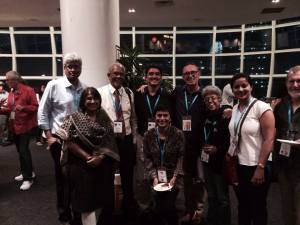
L-R: Venky and Swati, dear friends, and directors of Bookaroo; R Ramachandran, Executive Director, National Book Development Council of Singapore, fondly known as Rama; Kenneth Quek, Festival Director, AFCC; Ken Spillman; moi; Prashati Rastogi, German Book Office; almost falling off the edge, John McKenzie, leading academic and educator from new Zealand; and in inexplicable crouch-mode: Rosemarie Somiah, Singapore-based storyteller, writer and friend.
This year, the country focus was India. I had been asked to speak on a panel rather ambitiously titled: Past, Present, Future: Reinventing Indian Publishing for Children, which had sent me into something of a panic while I was preparing for it. Having collected reams of information from all my friends in Indian publishing, I finally ended up falling back on my own experience of having written for children over a decade now, using those experiences and examples to throw a light on the changes and trends in Indian publishing. While I touched upon the urban, English-speaking scenario, my co-panellist, the inimitable Subir Shukla provided some fascinating insights into the innovative methods being used in language publishing, especially in rural and small-town schoolrooms. I came away richer for it, and was grateful for the feedback from the audience, which was gratifyingly positive.
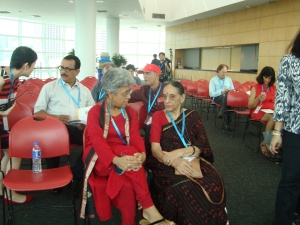
With Leila Seth before my session at AFCC 2014
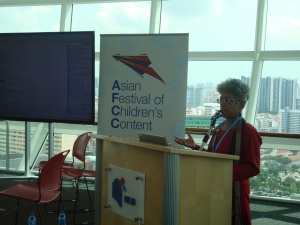
The same day, 2nd June, was my session with Mitali Perkins, US-based author, on YA: Books as Windows and Mirrors.
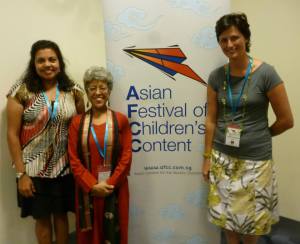
With Mitali Perkins and Deb Fitzpatrick
Rushing from The Pod (the breath-taking venue with an almost 360-degree view of the city from the top of the National Library Building), to the Multi-Purpose Room in the heart of the library itself, I found myself bursting—5 minutes late!—into a roomful of people patiently waiting, including my co-panellist and Deb Fitzpatrick, our moderator! For someone as pathologically punctual as me, this was something of an embarrassment, but was turned by Deb into a cause for merriment, erasing any initial awkwardness and enabling an easy plunge right into the discussion. Mitali and I had decided we would each make a little presentation, before opening it up for questions. My presentation was short, timed precisely to fit within 15 minutes. For those interested, here is what I said (and read):
‘When I asked myself, as the panel urges us to, “Why is it important that young adult audiences have books that not only provide insights into the lives of others but also serve as mirrors of their own lives and cultures” I could come up with four reasons right away:
i) To sensitize young adults to a world beyond their comfort zone
ii) Seemingly contradictory, but to me, absolutely essential and logical—To provide comfort: To make the young adult feel, “I am not alone. Someone just like me is suffering just like me”
iii) To ask difficult questions with the knowledge that they may not have easy answers, or any answer at all
iv) To make communication across generations possible
But since these are generalities, I would like to illustrate using a few examples from my own YA novel, Ela.
“The day I turned thirteen was the day I wanted to die.”
This is the line with which Ela, the protagonist of my YA novel, begins her story. It is this death-wish, deep and deeply-damaging, that sets the tone for the story of her life. And it is the word ‘lie’ hidden inside the word ‘life’ that rips apart the fabric of Ela’s hitherto “happy unsullied enviable” existence as a girl growing up inside the comfortable cocoon of upper-middle class urban privilege in India. To make it worse, not only is her life materially rich, it is also emotionally warm. In my fictional universe, Ela is not just an all-rounder child with a circle of friends and admirers, a gang of her own, and a self-confidence that seems unbreakable—she also has an incredibly open, loving and intimate relationship with her parents Smita and Mahesh, and her aunt, Jaya, Mahesh’s sister. It’s rare, but it is true, and it is precious. To give you an idea of Ela’s reality before what she calls the Catastrophe (with a capital C), allow me to read a tiny extract from the book:
And then they dropped the bombshell. I was to get ready for school.
It had been clear to me since the Catastrophe that I could never go back to school, never, not in a million years. How could I face them after the ghastliness they had witnessed? It would be all over school by now, Ela Chaudhary—basketball champ, English Miss’s pet, karate kid, drama queen, style guru—was not who we thought she was. Her parents, those super-cool parents everyone wanted, who never stressed her out, never pressured her, never told her ninety per cent or else, never sent her for this tuition and that tuition, allowed her plenty of internet time, even if they hovered over her shoulder, never told her you have to become a doctor or an engineer, do what you love, if you love writing, do that, if painting is your thing, sure, go ahead, just leave us alone after you’re eighteen, all right, parents who treated her like she was their age, who never embarrassed her in public like the others sometimes did, parents who told her, If you want to do anything stupid that’ll make you sick, tell us in advance so that we can keep the ambulance on stand-by, oh and if you do anything illegal, we’ll be the first ones to call the police, which made her laugh because surely they couldn’t mean it, which parent said such outrageous things, were they serious? Parents whom she didn’t have to hide things from, because hell what was there to hide, and who could hide anything from x-ray eyes anyway, parents who took all the fun out of being gross because they could be super-gross in return, parents who always turned up for PTA meetings, always remembered friends’ names and never used pet names in public, those unbelievably-decent super-cool parents of Ela Chaudhary were not even her own parents. She was adopted. No, she was picked up from the street. Nobody knows where she came from. Which dustbin. Nobody wanted her till Mahesh-Uncle Smita-Aunty took pity on her. Someone threw her away and they brought her home like a stray pup. No one knows who her real parents are.
[Pg 22-23, Ela]
And thus, the unshakeable core of her selfhood is shattered. It happens in the most brutal way, with a neighbour announcing at her birthday party that she needn’t bother defending her parents, because they aren’t even her real parents, she had been “picked up from the street” and that her son was never going to play “with such a dirty girl again” because who knew “which dustbin she came out of”.
At which moment Ela turns to her parents, and says:
She’s a liar, tell me she’s lying, why didn’t you tell her to stop uttering such hilarious lies in front of all my friends, why did you let her? The questions rose wildly to my tongue and died as I turned my face to see the truth written on Mahesh’s stony jaw, in Smita’s quivering lips, it was not Ashok’s mother who had lied—it was mine.
The nothingness opened at my feet, the thick hot darkness dropped on me with a flap of its terrible wings. There were no bones in me anymore, I was no more than a sac of skin, half-empty, half-full of water, wobbling and loose all over except at the shoulder where I felt the talons dig, if they dug any harder I would burst open and the water would flow out and drown them all.
In the room once glorious with light and music and life, my life, there was a smell of death, a pall of silence. If they had dragged a knife through me, if they had fretted me open with bullets, strangled me with rope, hacked me with an axe, the pain could hardly have been worse. Their eyes—not Ashok’s (hateful), not his mother’s (triumphant)—but my friends’ eyes, the uncomprehending baffled horror-struck eyes of my beloved friends, eyes I could never meet again. Everyone looking at me and I looking at them, Smita and Mahesh, progenitors of a terrible lie, red-handed, pretending even now, as Mahesh said, I think you had all better go home, Ela, why don’t you give them their return-presents, his voice out of that silence like an avalanche of rocks crashing on me, me turning my back on the room, on them all, and fleeing, no steps where the steps should have been, just a blankness that my feet flew over as if the monster bird had given me wings, saving me from one abyss only to swoop me down to the edge of another, my room, once-beautiful-haven, now hellish brink of my sorrow.
[Pg 8-9, Ela]
Ela goes from “beautiful haven” to “hellish brink” so swiftly and suddenly that she has no defences to deal with it. And so begins her downward spiral into a self-destructive zone from which her family despairs of ever getting her back. But as a result of this Catastrophe, two things happen:
One—Ela has to leave her comfort zone of gizmos and girlfriends, and confront a different reality. This is the reality that surrounds her, and most of us, living in India, the reality of class-difference, the reality of street-children, the reality of prejudice. Her key question: “Why hadn’t her parents told her she was adopted” – opens, as it were, a window into another world, the world of under-privilege:
Why hadn’t they told me?
Because it was too horrible to tell. Which meant I couldn’t have come from dear Manju’s soft wobbly stomach and her clean and tidy room after all. I must have come from the dirtiest part of the world, where no one went, the part where slime lived, where sewers ran, where rats as big as dogs gnawed on the toes of sleeping children. I had seen such things while passing in the car, I had turned my eyes away, that was where I must have come from, a hole in the worst part of the world, kept hidden until they burned it down.
The word ‘slum’ entered my head and stayed there, touching everything. We had been taught to respect difference, to understand the words ‘privilege’ and ‘responsibility’, we had made visits to schools where under-privileged children studied, we had given them books and clothes and volunteered to teach them for a day, we had seen the rooms with bare floors and grilles like the bars of cages, we had walked through the unlit corridors throbbing with the same sound that filled our airy halls, we had marvelled at the colourful walls covered with drawings, maps, the alphabet, craft work, we had sat with the children who looked smaller than us even though they were our age, filled with a crazy energy that came bouncing at us like a kind of boundless joy, we had eaten with them, sitting on the floor in long rows, eaten rice, dal and bhaji with our fingers and drunk the Frooti that our school had sponsored, and I had been stunned by my shameful realisation that these were kids we would never consider equal, however much we were taught to, however much we might have wanted to, it was already too late, something separated us, something irreversible and horrendous, and when we walked out of the school and got into our buses and went back home we forgot it quickly, and pretended it had all been splendid, our noble social service for the year.
Taranna had been absent that day, her mother would not allow her to go, who knows what germs those people have, and Vijay had been given a mask, which the teacher angrily confiscated, and Yash had told us the next day of having to take a Dettol-bath the moment he got home. It was deep deep deep, this separation, a wound dividing us from them, and I was falling into it, no, I had come from it, and nobody knew until now, they never told me because it was too horrible to believe that I was them, not us. But what was worse was that even they who were not us had not wanted to keep me, had thrown me away, so that the new question was —Why didn’t they want me, what had I done that was so unforgivably bad?
Maybe I’d done nothing except being born the way I was. It must have been my skin. My dark-as-sin skin which Smita, Mahesh, Jaya Aunty (and I) thought gorgeous, dusky sultry hot, that girl of yours is going to be a heartbreaker when she’s all grown up, what are you saying, she already is, but no one else found it beautiful, maybe neither did they, maybe they were only pretending to make me feel better, because once I had heard an aunty say to Smita—Do something about that girl’s complexion, it’s okay for a boy, but for a girl, kuch toh karo, fairness-cream-sheam, nei toh no one will marry her, and Smita’s cold cold voice saying, No daughter of hers was going to be the victim of disgusting prejudices like that, her daughter would have far better ambitions than just finding someone to marry her, she’s beautiful the way she is, thank you very much, and anyone who couldn’t see that didn’t have eyes in their head, which I thought was much ruder than what the aunty had said. After that, Smita avoided her in the park or on the road, which I thought was very funny, I hadn’t really understood what the hoo-hah was about, but now I did. Now it hit me. That aunty had been telling the truth. My ugly black skin was a curse. So ugly even my own mother couldn’t bear it.
[Pg 38-40, Ela]
And two—Ela has to go on a quest, the toughest quest of all—in search of the answer to the question, “Who am I?” And this is where the crack in the mirror of her selfhood allows her to step through it into a mirror-world of fantasy. This is not the western fantasy world of teenage vampires and magicians. This is a world of grizzled boatmen, mangrove islands, a community of child rag-pickers presided over by a strange boy she meets in that other-world, which in the oddest way reflects and throws an unnerving uncanny light on this-world. It is only when Ela takes charge of her own story, and chooses to invent her own mythology, that she is able to deal with the rupture and heal herself. In this, her self-created fantasy, she is nameless, and all-powerful, she is The Girl Who Was Hatched From An Egg:
The Girl Who Was Hatched From An Egg came out shaking her soft wet limbs. The moment the dry earthair touched her, the slippery white film that coated her evaporated and she felt a new steadiness, a firmness in her body, which was no more than five minutes old. But inside she was ageless. She had been born countless times before. Since the beginning of time she had hatched out of the Egg, full-formed and invincible, ready for the Task that no one else could do.
This time the Task was so colossal, she, who did not know the word ‘fear’, felt a stirring inside that was not the white-hot joy that accompanied every birth. She had saved the southern coast from another cataclysm, she had sealed the rift that had threatened to swallow a whole city, she had stopped a killer disease from spreading by changing the way the wind blew, all this and more, she had done. But now she trembled. Now, she had to find her mother.
She never thought she had a mother. She was The Girl Who Was Hatched From An Egg, she had created herself. What had a mother to do with her? She slept and when it was time for her to do the Task, the Egg cracked of its own accord and she crawled out, a blemishless creature of unearthly glory, alive and whole and ready. She was neither bird nor human, but if the Elders had told her to look for her mother among the wild birds of the earth, she would not have felt so surprised. She had felt in her all kinds of powers, the birdness of an eagle as it swooped upon its prey, the fleetness of the water as it rushed along the banks, the treeness of a root as it pushed its mighty way through the earth. If her mother had been a tree, or an eagle or a river she would not have been surprised. But a human? A woman? Her heart shook and she had to place her hand where it fluttered, like a leaf.
It was not enough to simply find her mother. Once found, she had to stay. This was the part that hurt The Girl Who Was Hatched From An Egg the most. She could not return, she could not sleep until the next Call came, she could not keep her powers. She had to lay her powers down at her human mother’s feet like a warrior surrendering her weapons and be a True Child. That is what the world needs now, the Elders had told her. No more superhuman tasks. Give up being who you thought you were and be what you actually are, your mother’s True Child. That will be all, and everything.
[Pg 84-85, Ela]
With adoption on the rise in India, it isn’t unusual to have friends and family with adopted kids. What has taken me by surprise though, is the way in which this book makes people come up to me—adults who were adopted as kids; mothers who have one biological child and one adopted child, friends who know of cases where a child has come to know about being adopted at a later stage, and has gone into trauma, which makes me feel a shiver, because I wonder what Ela can do for that child? Can she help? Not just the child, but also the parent? Is there a way in which our fictions can address the hypocrisies and taboos of the adult world, and enable our young people to confront their worst nightmares? I do believe the best YA fiction is one small step in that direction. In a country as culturally complex and as socially iniquitous as India, sometimes even the person living across the road can seem like another country. But isn’t the mind of a young person also another planet? A universe unto itself? YA fiction can, I believe, be both window to the self-and-the-other, and mirror to us all.’
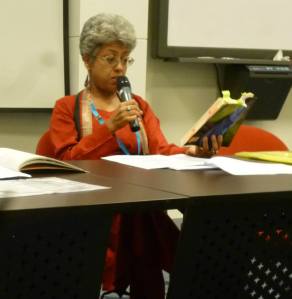
Reading from Ela at AFCC 2014, Singapore
The session was followed by Q&A. But the best thing that happened was that several of the people who attended, went out and got copies of the book! Among them was Leila Seth (who bought both Ela, and The Fried Frog for her grandchildren), and Fatima Sharafeddine, the highly-respected and prolific children’s author and translator who also delivered the Children’s Literature Lecture at AFCC 2014.
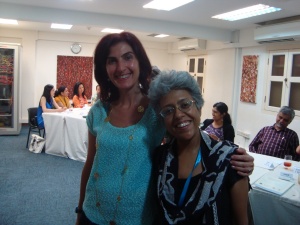
With Fatima Sharafeddine
I had the pleasure of spending time with Fatima, and she mailed me after reading Ela, saying how much she loved it. For me, the revelation regarding Ela has been the way adult-adults respond to it. Perhaps this is one of those YA adults which can easily crossover?
I also signed copies of both my books, at the Scholastic Booth in the Media Mart, a delightful experience as always. The Scholastic team later told me all copies but one each were sold out, which pleased me (and them) no end.
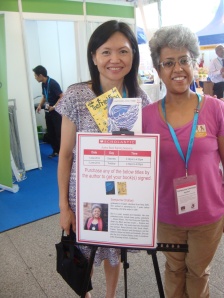
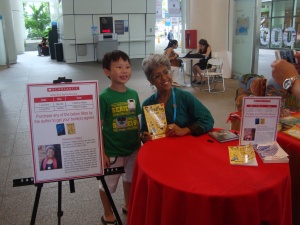
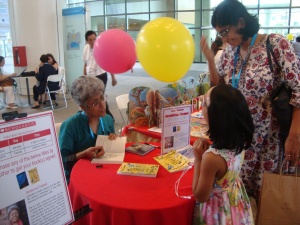
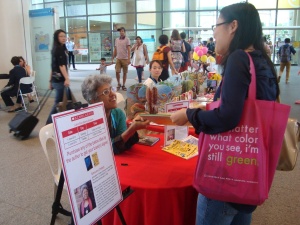
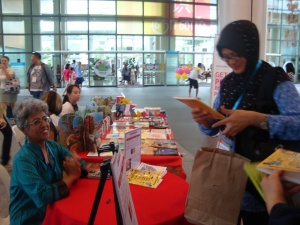
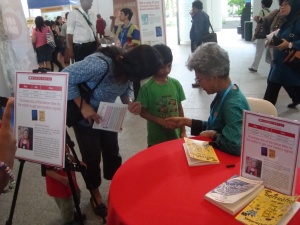
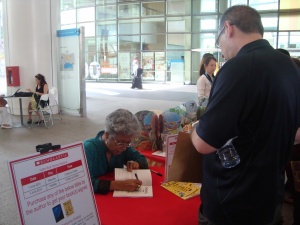
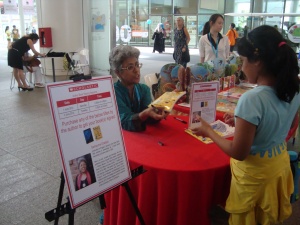
So that’s it for now, from the travels of Ela, the Fried Frog and their eternal and humble sidekick, Sampurna Chattarji, with love
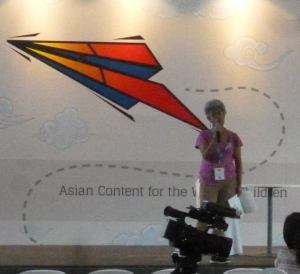
[Copyright for this blogpost and all extracts from Ela with the author ©Sampurna Chattarji 2014]
*An interview by Swasti Mitra Mustafi, 8B
Mahadevi Birla World Academy
- Tell us a little about yourself: I’m a writer, poet, novelist, translator with 12 published books till date. I always carry a book with me, even on the busiest day, when I know I won’t get any free time to read. If I don’t have a book with me, I feel I’m missing a limb! I am an obsessive type of person! I’m a perfectionist who gets mad if the details aren’t right. I love luchi-mangsho. (In fact I love luchis so much I wrote 2 poems in their honour in a series called ‘The Food Finagle’ from my book The Fried Frog and other Funny Freaky Foodie Feisty Poems.) I love walking, especially in the mountains.
- What were you like at school: I was a big reader. But that doesn’t mean I hung out only with other bookworms! I had friends who were great at sports and athletics, friends who were introverts (unlike me who was an extrovert, contrary to the stereotype of most bookworms!), friends who were in many ways my polar opposites. We all got along famously and invented many exciting scenarios for ourselves (including secret clubs and mystery trails, and invented codes and other such stuff). I loved drama, and elocution, and writing, and hiking. (I grew up in Darjeeling.) I took part in everything with great enthusiasm. And, I always came first in class! (I know, that’s really annoying!)
- What was your favorite show as a kid? Oh I had several: Little House on the Prairie, Knight Rider, Bewitched, Worzel Gummidge, Star Trek…
- Which writers inspire you ? (if any): Too many to name. Basically I am inspired by writers who move me with their ideas, their use of language, their inventiveness, wisdom, truth, playfulness, and their insight into the human condition…Writers who make me say, “I wish I had written that!”
- Do you think parentage is of so much importance to a child and this could be the shock of shocks to Ela to disintegrate her ?: No. What shocks Ela is the fact that her parents, whom she loves, have lied to her. The people she trusted most in the world have kept an essential truth from her, and she feels betrayed. That is why she disintegrates.
- Which group of readers did you write this book for? For young adults. For old adults. For anyone who has ever been a teenager. Anyone who has felt the pain of betrayal. Anyone who has suffered an identity crisis. Anyone who has ever felt alone, lost, confused, or friendless. Anyone who has struggled to come to terms with who she/he is. Anyone who believes that fantasy can help you cope with reality. Anyone who loves life but realizes how hard life can sometimes be. Anyone who has ever wished they were dead, only to realize how wonderful it is to be alive.
- What is the hardest thing about writing? The discipline of it. Keeping faith in your story day after day after day.
- Do you ever get ‘writers’ block? Not yet. Though I have struggled, for example, even when writing Ela, with certain patches. But so far, luckily I have managed to resolve them!
- Your favorite book or movie ? Too many to list! So here’s just 3 favourite books from just one genre (fantasy): Tolkien’s The Lord of the Rings, Ursula le Guin’s Earthsea Quartet, Philip Pullman’s Northern Lights.
- Favorite pass time other than writing? Writing, my dear, isn’t my pastime! It’s not a hobby, it’s not something I do to fill my time—it’s my life, my passion, my profession! When I’m not writing I love reading, watching movies, I love travelling, eating, talking to my friends – all the things that ‘normal’ people like to do!
- Your next book? A book of short stories on Kolkata.
- Some tips for young writers. Read read read before you begin to write write write! Learn all the rules of the language you want to write in, because unless you know the rules you won’t be able to break them! Don’t be in a hurry to be published. Learn to take criticism and gain from it. Don’t be afraid of hard work and solitude.
- Any special thoughts on the launch of your book on Rabindranth Tagore’s birthday? Was it planned or by chance? Would you like to say something about this ? Oh, this was just a happy coincidence! Serendipitous! And somehow, that made me feel specially blessed.
Sampurna Chattarji, Kolkata, May, 2014
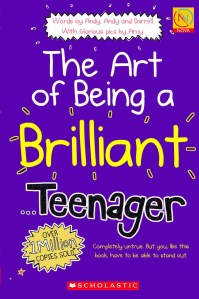 In fact, here’s the biggest thought of all; what if happiness is the starting point, not the end point. So, for example, what if it’s the happiest teenagers that do best at school? What if being happy now is the key to doing better homework and creating stronger relationships? What if mums don’t nag happy teenagers? (I appreciate that might be a pushing the point too far!)
In fact, here’s the biggest thought of all; what if happiness is the starting point, not the end point. So, for example, what if it’s the happiest teenagers that do best at school? What if being happy now is the key to doing better homework and creating stronger relationships? What if mums don’t nag happy teenagers? (I appreciate that might be a pushing the point too far!)

